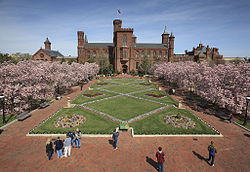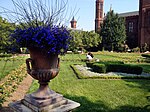Smithsonian Gardens
 Parterre of the Enid A. Haupt Garden | |
 | |
| Established | 1972 |
|---|---|
| Location | The National Mall, Washington, D.C. |
| Type | public gardens and archives |
| Director | Barbara Faust[1] |
| Public transit access | L'Enfant Plaza Metro Stop or Smithsonian Metro Stop (Washington Metro) |
| Website | gardens.si.edu |
The Smithsonian Gardens, a division of the Smithsonian Institution, is responsible for the "landscapes, interiorscapes, and horticulture-related collections and exhibits", which serve as an outdoor extension of the Smithsonian's museums and learning spaces in Washington, D.C.[2] Established in 1972[3] as a groundskeeping and horticulture program, Smithsonian Gardens currently manages 180 acres of gardens on the National Mall,[3] 64,000 square feet of greenhouse production space,[3] and the Archives of American Gardens, a research collection of over 60,000 photographs and archival records covering American landscape history from the 1870s to the present.[3][4][5]
History
In 1972, the eighth secretary of the Smithsonian, S. Dillon Ripley, established the Office of Horticulture, with the intention of extending the Smithsonian's research and education efforts to its outdoor spaces.[6] Ripley hired James R. Buckler as its first director and the first horticulturalist at the Institution.[7] The office was created at a time when gardening was increasing in popularity across the United States, and its educational mission was buoyed by this surge of interest from the public.[4] Buckler's first assignment was to research and plan for the Victorian garden that was installed between the Smithsonian Castle and Independence avenue in celebration of the United States Bicentennial in 1976. The popularity of the Victorian garden would later provide design inspiration for the Enid A. Haupt Garden's central parterre.[8]
Buckler served as director of the Office of Horticulture for 23 years. Buckler was succeeded by Nancy J. Bechtol, who served as the Director of the Horticulture Services Division from 1995 until 2002.[9][10][11][12]
In 2009, the Smithsonian Institution changed the name from the Horticulture Services Division to the Smithsonian Gardens;[13] the change was announced to the public in 2010.[14]
Gardens and landscapes

The gardens and landscapes managed by Smithsonian Gardens include:
- Butterfly Habitat Garden between the National Museum of Natural History and the National Gallery of Art Sculpture Garden
- Courtyard of the Freer Gallery of Art
- Enid A. Haupt Garden, a rooftop garden above the S. Dillon Ripley Center, Arthur M. Sackler Gallery, and National Museum of African Art, between the Smithsonian Castle and Independence Avenue
- Heirloom Garden at the National Museum of American History, Behring Center
- Sculpture Garden and Plaza of the Hirshhorn Museum and Sculpture Garden
- Kathrine Dulin Folger Rose Garden, on the east side of the Smithsonian Castle, in front of the main façade of the Arts and Industries Building
- Mary Livingston Ripley Garden, between the Arts and Industries Building and the Hirshhorn Museum and Sculpture Garden
- National Air and Space Museum's walled terraces
- Native Landscape at the National Museum of the American Indian
- Robert and Arlene Kogod Courtyard in the Donald W. Reynolds Center for American Art and Portraiture
- Victory Garden at the National Museum of American History, on the museum's west terrace[4]
- Urban Bird Habitat Garden, east of the entrance to National Museum of Natural History at the corner of Constitution Avenue and 12th Street[15]
Smithsonian Gardens practices integrated pest management as a way of controlling garden pests in all of the gardens and landscapes it manages. These methods are intended to produce as little hazard to people and the environment as possible.[4]
A plant production facility, completed in 2010, is located at the Museum Support Center in Suitland, Maryland serves as the base of production and maintenance of plant material for the gardens and horticultural exhibits throughout the Smithsonian Institution.[16][17] It houses numerous horticultural specimens, interior display plants, and also includes a greenhouse devoted to nectar plants used for the Butterfly Pavilion at the National Museum of Natural History.[18]
Prior to the building of the Suitland greenhouse facility,[13] plants were cultivated in 11 greenhouses located on the grounds of the U.S. Soldiers' and Airmen's Home in Washington, D.C.[19]
Collections
Smithsonian Orchid Collection
The Smithsonian Orchid Collection, which began with five plants in 1974,[20] and has grown into a significant conservation project as additional orchids were donated to the Smithsonian for "safekeeping" and propagation. It now comprises over 8,000 plants[20][21] representing 256 genera.[22] Specimens are featured in interior plant displays across the Smithsonian museums.[1]
Archives of American Gardens
The Archives of American Gardens is a research archive managed by Smithsonian Gardens, and is dedicated to providing landscape designers, historians, preservationists, students, and garden enthusiasts with access to photographic images and records that document over 6,300 historic and contemporary gardens throughout the United States.[5][23][24]
Garden Furnishings and Horticultural Artifacts Collection
With more than 2,500 items, the furnishings and artifacts in this collection provide historic insight into horticulture, floriculture, and garden design trends. Some of the antique cast-iron garden furnishings from this collection, including fountains, benches and urns, are exhibited in the Smithsonian gardens.[1]
See also
References
- ^ a b c "Smithsonian Gardens Factsheet". Newsdesk. Smithsonian Institution. Retrieved 22 October 2012.
- ^ "About Smithsonian Gardens". Smithsonian Gardens. Smithsonian Institution. Retrieved 17 October 2012.
- ^ a b c d "AHS 2012 Great American Gardeners National Award Winners" (PDF). American Horticultural Society. evening of June 7, 2012. Retrieved 22 October 2012.
{{cite web}}: Check date values in:|date=(help) - ^ a b c d Ottesen, Carole (2011). A Guide to Smithsonian Gardens. Smithsonian Books. pp. 20, 25. ISBN 978-1-58834-300-0.
- ^ a b "Archives of American Gardens". Smithsonian Gardens. Smithsonian Institution. Retrieved 22 October 2012.
- ^ S. Dillon Ripley, 1913–2001
- ^ "James Richard "Jim" Buckler". The Washington Post. October 15, 2003. Retrieved 22 October 2012.
- ^ Park, Edwards; Carlhian, Jean Paul (1987). A new view from the Castle : the Smithsonian Institution's quadrangle : Arthur M. Sackler Gallery, National Museum of African Art, S. Dillon Ripley Center, Enid A. Haupt Garden. Washington, D.C.: Smithsonian Institution Press. p. 45. ISBN 0-87474-749-X.
- ^ "SIA Acc. 05-245, Smithsonian Institution Office of Facilities Management Horticulture Services Division Office of the Director, Subject Files, 1989–2003". Smithsonian Institution Archives.
- ^ "Nancy Bechtol". Zoom Info. Retrieved 22 October 2012.
- ^ May, Joe (Winter 2009–2010). "Nineteenth Annual IAMFA Conference" (PDF). PAPYRUS WINTER 2009–2010. PAPYRUS. Retrieved 22 October 2012.
- ^ "World-Class Facilities, The". Facilities Engineering Journal. 39 (July | August 2012): 19 of 36. 2012.
- ^ a b Chris Matt, Chris Matt (August 2010). "Smithsonian Gardens: Roof Garden Poses Maintenance Challenges". Facilities Net. Retrieved 22 October 2012.
- ^ "Strategic Plan, FY 2010–2015" (PDF). Smithsonian Gardens. Smithsonian Institution. Retrieved 22 October 2012.
- ^ "Urban Bird Habitat Garden". Exhibitions. Smithsonian Institution. Retrieved 24 October 2012.
- ^ "Bloom Time at the Smithsonian". Smithsonian Magazine. Smithsonian Institution. Archived from the original on 3 February 2013. Retrieved 17 October 2012.
{{cite web}}: Unknown parameter|dead-url=ignored (|url-status=suggested) (help) - ^ NPR Staff (August 15, 2010). "Smithsonian Catalogs Life Before The Gulf Spill". National Public Radio. Retrieved 23 October 2012.
- ^ "Current Exhibitions". National Museum of Natural History.
- ^ Heyman, I. Michael (April 1997). "Smithsonian Perspectives". Smithsonian Magazine. Archived from the original on 2013-02-02.
{{cite journal}}: Unknown parameter|dead-url=ignored (|url-status=suggested) (help) - ^ a b "17th Annual Orchid Exhibition "Orchid Mystique: Nature's Triumph". Gold Coast Cymbidium Growers. Retrieved October 23, 2012.
- ^ "Smithsonian Flowers by FTD". FTD. Archived from the original on July 8, 2012. Retrieved October 23, 2012.
{{cite web}}: Unknown parameter|deadurl=ignored (|url-status=suggested) (help) - ^ "A Case Study of Nature's Jewels: A Living Exhibit of Orchids and Butterflies". Office of Policy and Analysis, Smithsonian Institution. August 2003.
{{cite web}}: Missing or empty|url=(help) - ^ "Landscape Studies Online Resources". Foundation for Landscape Studies. Retrieved 26 January 2012.
- ^ Osster, Douglas (September 22, 2001). "Gardens stay evergreen in archive". Pittsburgh Post-Gazette. Pittsburgh, PA: PG Publishing Co., Inc.
Further reading
- Choukas-Bradley, Melanie, and Polly Alexander. City of Trees: The Complete Field Guide to the Trees of Washington, D.C. University of Virginia Press, 2008.
- Fletcher, Valerie J. A Garden for Art: Outdoor Sculpture at the Hirshhorn Museum. Thames and Hudson, 1998.
